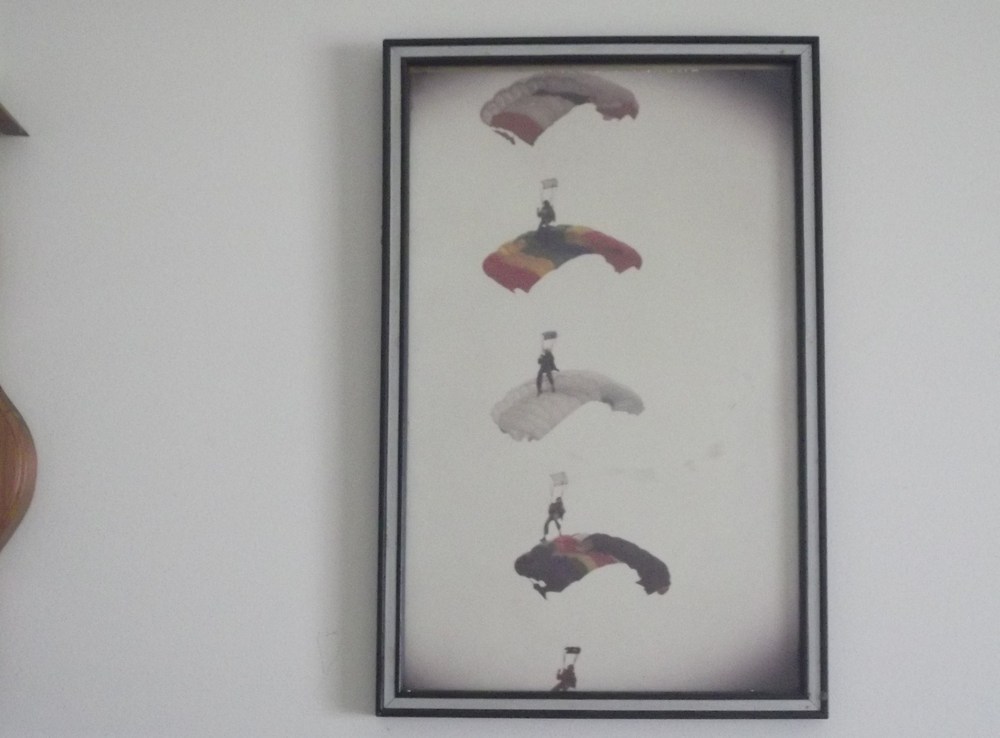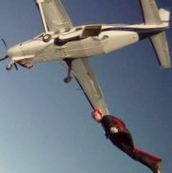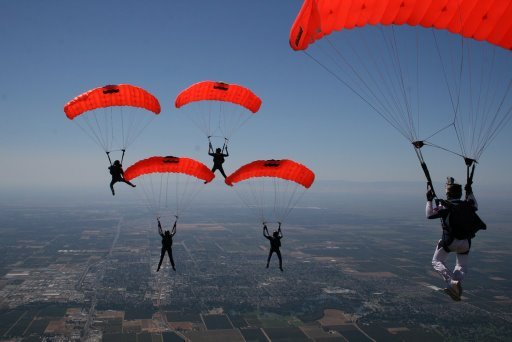Recommended Posts
Bolas 5
Quotepeople shouldn't be swooping until they have enough jumps and training to be able to handle those canopies in all conditions and the judgement to know what not to swoop.
What your argument leads to is jumpers pushing the downsizing and rushing to HP canopies because they want to swoop, and those are 'safer', and in those cases that's not the case. The canopies dive longer, fly faster, and require greater care and judgement to fly safely, and if you don't have that, they're not 'safe' for any purpose.
Agree with you but if someone is jumping at a 90 only DZ or only has 90 only DZs near them, who/how are they going to get this training? Without being able to do larger turns, how can they safely downsize?
Unless the 90 only DZ allows larger turns on low passes the only way they'll be able to get more speed is to downsize
If ya can't be good, look good, if that fails, make 'em laugh.
QuoteAgree with you but if someone is jumping at a 90 only DZ or only has 90 only DZs near them, who/how are they going to get this training? Without being able to do larger turns, how can they safely downsize?
How can anyone safely downsize? It's simple, spend adaquate time on each canopy size and type that you can develop, practice and demonstrate a full range of canopy control skills in a full range of conditions.
If you only have access to a '90 only' DZ, then you simply have 90 degree turns as your 'top skill'. Want to downsize? Great, put in the time to build up to, and then demonstrate a solid, reliable, 90 degree turn on your current canopy, then get a smaller canopy and start over at the beginning.
What's the point in learning or concerning yourself with a bigger turn if you only have access to DZs that only allow 90s?
Even if you travel to a DZ with no turn limitation, as a jumper from a '90 only' DZ, it's your responsibility to recognize that and limit your activites to those within your abilities.
tmccann 1
QuoteTim, If you profile is correct (74 jumps and 1 year in the sport) you are one of the people that doesn't know what he doesn't know.
Yup. I'll be the first to admit it - I'm a newbie. I keep a student mentality - there is a lot of advice out there, especially on the internet. If I tried to take all the advice I was given, I would be paralyzed by indecision. And then die. Instead, I try to keep an open mind when reading books and internet discussions (without ever trying anything I read about), and when I go to the DZ, I ask advice of experienced jumpers/coaches who I know and trust, and ask them why people who are very experienced seem to vary so much in their opinions. It's usually because there's a whole lot I don't know, and it helps keep me aware of that.
QuoteIf you think that 50% of the fatalities last year (Low turns/ Canopy collisions caused by low turns) happening under fully functional Canopies is somehow acceptable I despair for the future of the sport.
Nope; if you read my profile, then you know where I jump, and you obviously know that it's been a very rough time in that general vicinity for casualties in the time I've been in the sport. That's why I read these threads, even when there doesn't seem to be anything new being said. I've read variations of exactly the same discussion going on here in several others.
Mari, I know you are very well-intentioned, but you just sound like the codger yelling at the kids, and it gets a little old without any new ideas thrown into the mix. How are we as a sport going to get to that the new, as-yet-unknown path that DSE alluded to without new ideas from the experienced jumpers who know all those things I don't?
Tim
Bolas 5
QuoteQuoteAgree with you but if someone is jumping at a 90 only DZ or only has 90 only DZs near them, who/how are they going to get this training? Without being able to do larger turns, how can they safely downsize?
How can anyone safely downsize? It's simple, spend adaquate time on each canopy size and type that you can develop, practice and demonstrate a full range of canopy control skills in a full range of conditions.
If you only have access to a '90 only' DZ, then you simply have 90 degree turns as your 'top skill'. Want to downsize? Great, put in the time to build up to, and then demonstrate a solid, reliable, 90 degree turn on your current canopy, then get a smaller canopy and start over at the beginning.
What's the point in learning or concerning yourself with a bigger turn if you only have access to DZs that only allow 90s?
Even if you travel to a DZ with no turn limitation, as a jumper from a '90 only' DZ, it's your responsibility to recognize that and limit your activites to those within your abilities.
This could lead to people jumping highly loaded cross braced canopies that have never done more than a 90. To me that's a way scarier thought than allowing large turns separated by space and time.
If ya can't be good, look good, if that fails, make 'em laugh.
Quote
Agree with you but if someone is jumping at a 90 only DZ or only has 90 only DZs near them, who/how are they going to get this training? Without being able to do larger turns, how can they safely downsize?
By taking their canopy through its paces (landing cross-wind, down-wind, up-hill; making carving landings; swoop accuracy parking it in the pea gravel; etc.), getting proficient with 90 degree turns, and putting at least a few hundred jumps on it (although a few hundred more are better).
It's also not that slow.
When one of the car guys broke out a RADAR gun at our DZ I got 48 MPH from a mellow carving 90 under my Stiletto 120 around 1.5 pounds per square foot which is like the stall speed of a Cessna 152 with the flaps down. Better piloting and/or a more modern design trimmed steeper would have been higher. That's plenty for a guy with 500-700 jumps.
The Lodi 90-only swoop contest winners clocked 71 MPH through the gates (VX86 @ 2.4) and got a 206 foot toe drag (Velocity 84 @ 2.3). While not competitive at the world level that sort of performance should be ample for the fun swooper with more experience.
Quote
Unless the 90 only DZ allows larger turns on low passes the only way they'll be able to get more speed is to downsize
That's fine. With a turbine DZ it needn't take even six months to rack up a few hundred jumps on a canopy (when they let you out at 3000-4000 feet you can be packed and waiting before the plane lands) which is more than it takes to stay within accepted wingloading guidelines like Brian Germain's WNE.
Quote
This could lead to people jumping highly loaded cross braced canopies that have never done more than a 90. To me that's a way scarier thought than allowing large turns separated by space and time.
What, because some one is accidentally going to slip and pull a 180 or 270 instead of stopping their turn at 90 degrees?
I don't think so. It's not like eschewing high performance landings completely leaving people with no experience landing at faster than trim speeds which happens when they fail to turn flat enough at low altitudes and 90 degrees still yields enough energy for low-altitude and post-plane out carves.
Bolas 5
QuoteQuote
This could lead to people jumping highly loaded cross braced canopies that have never done more than a 90. To me that's a way scarier thought than allowing large turns separated by space and time.
What, because some one is accidentally going to slip and pull a 180 or 270 instead of stopping their turn at 90 degrees?
I don't think so. It's not like eschewing high performance landings completely leaving people with no experience landing at faster than trim speeds which happens when they fail to turn flat enough at low altitudes and 90 degrees still yields enough energy for low-altitude and post-plane out carves.
If one has only ever been allowed to make 90 degree approaches, if put into a situation where they need to turn more than 90...
It's sort of like when people were told "no low turns" and either panic turned at the last minute or had collisions with easily avoidable objects. This is not an issue per se for swoopers as they tend to know their canopy.
Just another example of misguided attempts to protect people from swooping putting them at risk in other ways.
If ya can't be good, look good, if that fails, make 'em laugh.
QuoteQuoteQuote
This could lead to people jumping highly loaded cross braced canopies that have never done more than a 90. To me that's a way scarier thought than allowing large turns separated by space and time.
What, because some one is accidentally going to slip and pull a 180 or 270 instead of stopping their turn at 90 degrees?
I don't think so. It's not like eschewing high performance landings completely leaving people with no experience landing at faster than trim speeds which happens when they fail to turn flat enough at low altitudes and 90 degrees still yields enough energy for low-altitude and post-plane out carves.
If one has only ever been allowed to make 90 degree approaches, if put into a situation where they need to turn more than 90...
It's sort of like when people were told "no low turns" and either panic turned at the last minute or had collisions with easily avoidable objects. This is not an issue per se for swoopers as they tend to know their canopy.
Just another example of misguided attempts to protect people from swooping putting them at risk in other ways.![[:/] [:/]](//www.dropzone.com/applications/core/interface/js/spacer.png)
Can you indicate a situation where a front riser 180 down low would be necessary?
Does that scenario outweigh the hundreds and hundreds of injuries and fatalities we have seen over the years? And not just to the jumpers involved, but the jumpers they have collided with, spectators hit on the ground, etc.
top
billvon 3,100
>I made a 300-foot entry turn mistake and fixing it was a yawner. She
>made a 30-foot error and died.
And I have several friends who were flying straight in, screwed up and died.
Based on this it might seem like you could draw the conclusion "therefore big turns are safer than small ones, and small turns are safer than straight in approaches" but that would be faulty reasoning.
Bolas 5
QuoteQuoteQuoteQuote
This could lead to people jumping highly loaded cross braced canopies that have never done more than a 90. To me that's a way scarier thought than allowing large turns separated by space and time.
What, because some one is accidentally going to slip and pull a 180 or 270 instead of stopping their turn at 90 degrees?
I don't think so. It's not like eschewing high performance landings completely leaving people with no experience landing at faster than trim speeds which happens when they fail to turn flat enough at low altitudes and 90 degrees still yields enough energy for low-altitude and post-plane out carves.
If one has only ever been allowed to make 90 degree approaches, if put into a situation where they need to turn more than 90...
It's sort of like when people were told "no low turns" and either panic turned at the last minute or had collisions with easily avoidable objects. This is not an issue per se for swoopers as they tend to know their canopy.
Just another example of misguided attempts to protect people from swooping putting them at risk in other ways.![[:/] [:/]](//www.dropzone.com/applications/core/interface/js/spacer.png)
Can you indicate a situation where a front riser 180 down low would be necessary?
Does that scenario outweigh the hundreds and hundreds of injuries and fatalities we have seen over the years? And not just to the jumpers involved, but the jumpers they have collided with, spectators hit on the ground, etc.
top
No turns over 90 is just that, be they initiated with toggles, harness, or risers.
Scenario. A non swooper goes too far on their crosswind leg over trees and to adjust back to their landing area now has to make a turn larger than 90. As they've never done this and were NOT even allowed to:
* They make the larger turn and unfamiliar with the added speed ...
* They do a 90 and then do another turn after, possibly too low...
* They do their 90 and crash into trees or panic turn at the last minute to avoid...
It's highly likely that the above jumper even if allowed to make larger turns wouldn't practice or try them but that would be theirt whereas if a DZ bans them it becomes the DZs fault for limiting a jumpers "bag o' tricks" they can practice/use.[
If ya can't be good, look good, if that fails, make 'em laugh.
Quote
If one has only ever been allowed to make 90 degree approaches, if put into a situation where they need to turn more than 90...
If they've run out of altitude they pull both toggles down to 3/4 brakes to kill their descent rate and forward drive, lift the outside one part way to get a nice balance between flat and a quick pivot, keep it there for twice the rotation they would at 90 degrees, and should be ready for a PLF if they can't get back to full flight before landing and aren't used to flaring from that sort of braked position.
The difference in that flight regime between 90 and 180 degrees or with and without a short base leg between such turns in the landing pattern is not large.
This works for all sorts of canopies - I own 105 and 120 square foot ellipticals, a ZP 135 square, and a couple of 245 F111 seven cells and it does the job on all of them.
Here's a Scott Miller article circa 1998
http://www.performancedesigns.com/docs/98_low.pdf
If they never practiced flat turns or slow speed flight and just yank the inside toggle they could be screwed, although the root problem is that they never learned what their toggles could do not that they've never turned 180 degrees without a short base leg separating the first and last 90 degrees.
QuoteQuotesorry, dave, that's a load of hooey.
When I made my mistake, I had hundreds of feet to fix it; my friend had 30.
Game over.
It's not hooey, it's all about the degree of the mistake that was made. Your mistake was smaller in respect to what the canopy was capable of, and your friends mistake was larger in that same respect. If you has made a mistake of the same magnitude that she did, you would have also died on that day.QuoteAnd the worst part was that she died precisely because of the flawed thinking you just exhibited.
Lightly loaded, fast recovery is precisely the wrong canopy on which to swoop because, drum roll please, you gotta turn so low to keep the speed up for your swoop that you are instantly in the death zone as soon as you start your entry turn, with no room for error.
I never suggested that those type of canopies were better for swooping, just that they would reach a lower overall speed. What I did suggest is that if you made a large error on any canopy you're going to have a problem.
I swooped a Sabre 1 for years with no problem. I was loading a 135 at 1.3 or 1.4, and doing nothing but a quick 180 'wingover' with a riser. That was the style at the time, and the canopy I had the skill to jump, and I made it out just fine. I went on to downsize to another 'square' Sabre 1 107, and swooped that one for years without any problem.
The flaw in your thinking, or at least the way you're presenting it, is that it gives people the idea that they should be jumping long diving canopies at higher WL if they want to swoop. That might be your point, and in a way I can agree, but what you're not saying is that people shouldn't be swooping until they have enough jumps and training to be able to handle those canopies in all conditions and the judgement to know what not to swoop.
What your argument leads to is jumpers pushing the downsizing and rushing to HP canopies because they want to swoop, and those are 'safer', and in those cases that's not the case. The canopies dive longer, fly faster, and require greater care and judgement to fly safely, and if you don't have that, they're not 'safe' for any purpose.
The answer is the pilot, not the parachute. Take Mario Andretti as an example. Put him on a race track in a street car, with street tires and street suspension/brakes, and tell me that it's more 'dangerous' than a race car. We both know that Mario will have no problem hustling the car around the track at 10/10ths, and everyone will come back to the pits in one piece. It's not about the equipment, it's about the driver (pilot). If the pilot is qualified, you can swoop anything safely, from a Sabre 1, to a Navigator, to a tandem.
Trying reading the article first, then we can continue.
44
"The beginning of wisdom is to first call things by their right names."
Quote>Basic facts:
>I made a 300-foot entry turn mistake and fixing it was a yawner. She
>made a 30-foot error and died.
And I have several friends who were flying straight in, screwed up and died.
Based on this it might seem like you could draw the conclusion "therefore big turns are safer than small ones, and small turns are safer than straight in approaches" but that would be faulty reasoning.
Sorry, the faulty reasoning lies with you: I never said any such thing.
It's not turn-dependent; it's ALTITUDE dependent. What part of that is so hard for everyone to undertand?
I was jumping a canopy with a huge recovery arc so when I botched my entry, I had 300 feet to fix it; no problem. When my friend botched her landing on a small recovery arc canopy, she had 30 feet to fix it; game over.
Please read my article attached above that was inspired by her death and then we can continue.
44
"The beginning of wisdom is to first call things by their right names."






.thumb.jpg.4bb795e2eaf21b8b300039a5e1ec7f92.jpg)

That's why they SEPARATE canopies in time or space at good DZs, rather than banning things.
Landing would be so freaking boring without being able to swoop on every jump. I'd hope jump prices be halved to make up for the loss in fun. Either that, or I'd have to go back to accuracy as I used to do and 260+ sq ft canopies. Slow but at least not mentally dull like some normal landing.
Not getting killed by a swooper never bores me.
Share this post
Link to post
Share on other sites